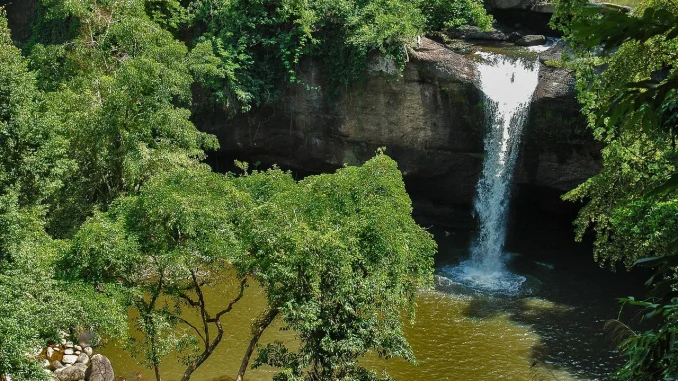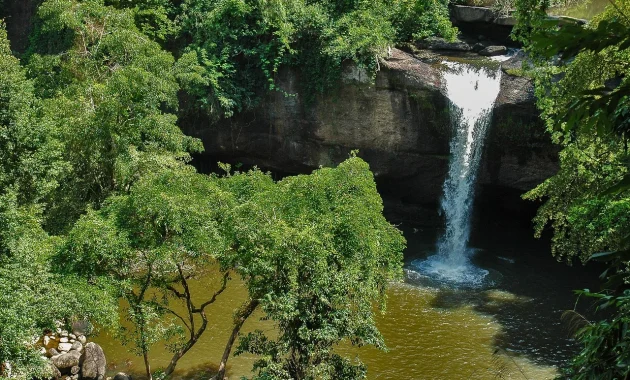
Nestled in the heart of Thailand, Khao Yai National Park stands as a beacon of biodiversity and natural beauty. Spanning over 2,168 square kilometers, this UNESCO World Heritage site is a sanctuary for wildlife and a paradise for nature enthusiasts. In this comprehensive guide, we will take you through the myriad wonders of Khao Yai, from its lush forests and majestic waterfalls to its diverse wildlife and exhilarating hiking trails.
Introduction to Khao Yai National Park
Established in 1962, Khao Yai is Thailand’s first national park and one of the largest in the country. Located just a few hours’ drive from Bangkok, it offers a perfect escape from the hustle and bustle of city life. The park encompasses diverse ecosystems, including tropical seasonal forests, grasslands, and montane forests, providing a habitat for an array of flora and fauna.
Flora and Fauna: A Biodiversity Hotspot
Rich Flora
Khao Yai’s dense forests are home to an impressive variety of plant species. The park’s vegetation includes tropical evergreen forests, mixed deciduous forests, and hill evergreen forests. Towering trees, vibrant orchids, and lush undergrowth create a verdant landscape that changes with the seasons. During the rainy season, the forest floor is carpeted with a plethora of wildflowers, making it a botanist’s dream.
Abundant Wildlife
Khao Yai is renowned for its wildlife, offering sightings of some of the most elusive and endangered species. The park is home to over 300 species of birds, including the Great Hornbill and the Siamese Fireback. Mammals such as elephants, gibbons, and Asiatic black bears roam the forests, while smaller creatures like civets, porcupines, and pangolins can also be spotted.
One of the most thrilling experiences in Khao Yai is encountering the Asian elephant in its natural habitat. These majestic creatures often make their way to the park’s grasslands and water sources, offering visitors a chance to observe them up close.
Waterfalls: Nature’s Masterpieces
Haew Narok Waterfall
The most famous waterfall in Khao Yai, Haew Narok is a three-tiered cascade with a total height of 150 meters. The trek to the waterfall takes you through dense jungle and offers stunning views. The powerful rush of water and the surrounding lush greenery create a breathtaking scene, especially during the rainy season when the waterfall is at its most impressive.
Haew Suwat Waterfall
Popularized by the film “The Beach,” Haew Suwat is another spectacular waterfall in Khao Yai. The 20-meter drop into a deep pool below is perfect for photography and offers a serene spot to relax and enjoy the natural beauty. The easy access makes it a favorite among tourists.
Pha Kluai Mai Waterfall
For those seeking a more secluded experience, Pha Kluai Mai is an ideal choice. This waterfall, surrounded by orchids and bamboo groves, offers a peaceful retreat away from the crowds. The area is also a great spot for birdwatching and picnicking.
Hiking Trails: Adventures Await
Khao Yai boasts an extensive network of hiking trails that cater to all levels of hikers, from easy walks to challenging treks.
Khao Yai’s Easy Trails
For beginners or those looking for a leisurely stroll, the Pha Kluai Mai to Haew Suwat trail is perfect. This 3-kilometer trail takes you through bamboo forests and along a river, ending at the picturesque Haew Suwat Waterfall. The trail is well-marked and offers plenty of opportunities to spot wildlife.

Moderate Trails
For a bit more challenge, the Kong Kaeo trail offers a moderate hike through diverse terrain, including grasslands and dense forests. This trail is around 7 kilometers long and provides stunning views of the park’s landscape. Keep an eye out for deer and gibbons along the way.
Advanced Trails
Experienced hikers will enjoy the Khao Laem trail, a strenuous 8-kilometer trek that ascends to one of the park’s highest peaks. The trail offers panoramic views of Khao Yai’s lush valleys and dense forests. The journey is challenging, but the reward is well worth the effort.
Wildlife Watching: A Thrilling Experience
Best Spots for Wildlife Viewing
Khao Yai is a haven for wildlife enthusiasts. The park offers several excellent spots for wildlife watching, including Mo Singto and Lam Takhong. These areas are frequented by large mammals, including elephants and deer, especially during the dry season when animals come to drink at the waterholes.
Night Safaris
For a unique experience, the park offers night safaris where you can see nocturnal animals in their natural habitat. The guided tours provide a chance to spot creatures like leopards, civets, and porcupines, adding an element of excitement to your visit.
Accommodation: Where to Stay in Khao Yai
Khao Yai offers a range of accommodation options, from camping in the park to staying in luxury resorts nearby.
Camping
For those who want to immerse themselves in nature, the park provides several camping grounds. Campsites like Lam Ta Khong and Pha Kluai Mai offer basic amenities and the chance to experience the park’s wilderness up close. Waking up to the sounds of the forest is an unforgettable experience.
Resorts and Lodges
If you prefer more comfort, there are numerous resorts and lodges located just outside the park. These accommodations offer modern amenities while still providing easy access to the park. Popular options include Kirimaya Golf Resort and Spa, Thames Valley Khao Yai, and the Greenery Resort.
Tips for Visiting Khao Yai National Park
Best Time to Visit
The best time to visit Khao Yai is during the cool season from November to February. The weather is pleasant, and the chances of spotting wildlife are higher. The rainy season, from May to October, brings lush greenery and full waterfalls, but some trails may be slippery.
What to Bring
When visiting Khao Yai, it’s essential to come prepared. Pack comfortable hiking shoes, light clothing, a hat, sunscreen, insect repellent, and plenty of water. Binoculars and a camera are also recommended for wildlife viewing and capturing the park’s stunning scenery.
Park Regulations
To protect the park’s natural beauty and wildlife, visitors must adhere to the park’s regulations. These include staying on designated trails, not feeding the animals, and carrying out all trash. Respecting these rules helps preserve Khao Yai for future generations.